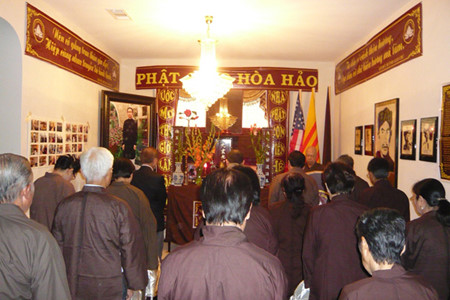At the time when Huynh Phu So founded Hoa Hao Buddhism, the number of followers was still small and predominantly congregated in the region of Hoa Hao. However, in 1940, after the Nam Ky (South Vietnam) uprising broke out and was savagely suppressed by French colonists, more and more people turned to this religion for consolation and salvation. By the end of that year, the number of followers had reached several hundred thousand. At the same time, the French were worried about Huynh Phu So’s influence and the growth of Hoa Hao Buddhism, so they invited him to Sa Dec and had him watched. Because of the protests of his followers, the French were forced to release him. Nevertheless, they did not feel secure, especially when Japan entered Indochina. Therefore, they brought him to the Cho Quan Hospital (Sai Gon) and justified their actions by claiming that he was insane. In mid-1941, Huynh Phu So was transferred to Bac Lieu and placed under surveillance. There, he made friends with many intellectuals like Nguyen Van Hau, Phan Ba Cam (or Vuong Kim), and Nguyen Xuan Thiep (or Viet Chau), and they often exchanged views on religious issues and the current situation.
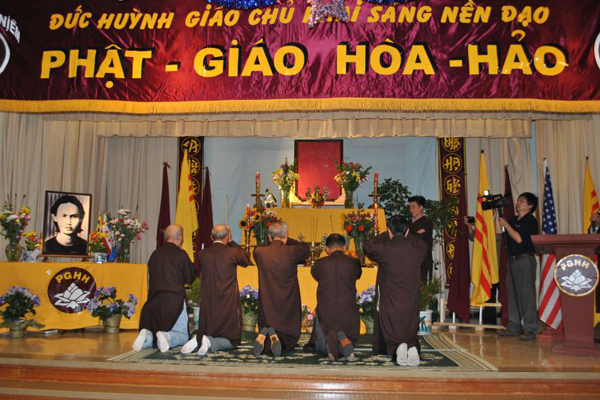
When Hoa Hao Buddhism extended its influence into the Mekong River Delta, Huynh Phu So was able to win the hearts of several important believers, some of whom came from the underworld and had the financial means to support the religion’s activities. These benefactors included Tran Van Soai, Nguyen Giac Ngo, Lam Thanh Nguyen, Le Quang Vinh, and Huynh Minh Tri. Lam Thanh Nguyen, alias Hai Ngoan, was from Cai Dau. Being the son of a Chinese landlord, he had a royal lifestyle and an addiction to gambling. Worried over a superstitious rumor, he became a follower of Hoa Hao Buddhism.
When the Japanese entered Indochina, they quickly realized the importance of Huynh Phu So and Hoa Hao Buddhism’s followers in the Mekong River Delta. Therefore, they attempted to draw him to their side.
In 1942, the Japanese secret agents kidnapped him from the French and took him back to Sai Gon. There, with the help of the Japanese, he formed relationships with some politicians like Nguyen Bao Toan (Dai Viet Phiet), Tran Van Phiet (Patriotic Youth Union), and Tran Van An (Vietnam National Restoration). Perhaps because of these relationships, he was able to play a role in the political sphere.
After the Japanese staged a coup d’etat against the French on September 3, 1945, the Japanese assisted Huynh Phu So in taking two trips to the Western part of South Vietnam to encourage agricultural expansion and strengthen his force. In March 1945, he and his trustworthy followers campaigned for the establishment of the Campaign Society for Vietnam’s Independence (Vietnam Doc lap Van dong hoi). Unfortunately, their attempt failed. Later, in April 1945, Huynh Phu So introduced a program campaigning for the establishment of the Vietnamese Buddhist Union (Vietnam Phat giao Lien hiep hoi) and even wrote its political program. However, his Le Quang Vinh, alias Ba Cut, was from Bang Trang. When he was small, he went into a landlord’s service. He was very pugnacious, often fought, and was a snatch-boy. He went to That Son to learn martial arts and became Huynh Phu Sos follower.
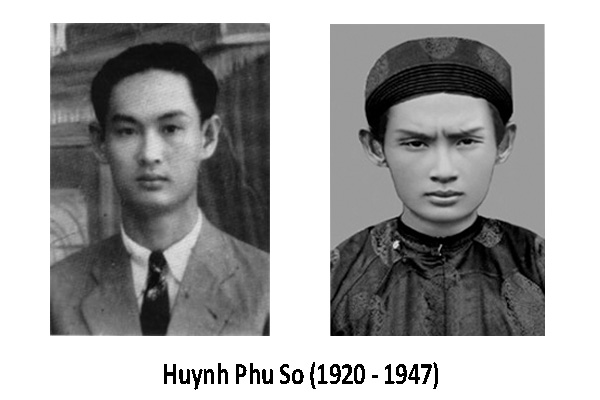
Huynh Minh Tri was from Cu Chi, Sai Gon. He was once a well-known person in the underworld. He became a high-ranking officer in the Vietnamese People’s Army and was prestigious and influential among the believers of Hoa Hao Buddhism.
The plan was not appreciated by the Buddhist world. After his unsuccessful efforts, he and his confidants returned home to build and reinforce their religious organizations. They founded the management committees of Hoa Hao Buddhism in some provinces. Huynh Phu So was head of the Central Management Committee of Hoa Hao Buddhism; Luong Trong Tuong was the general secretary. The organizational structure of Hoa Hao Buddhism was officially formed. Along with the administrative components, it’s civil guards-a sort of armed forces-were built in the bases of the religion. This force was commanded by Huynh Phu So’s disciples such as Le Quang Vinh, Tran Van Soai, Lam Thanh Nguyen, and Nguyen Giac Ngo.
During the preparation of the general uprising, Huynh Phu So played a part in the establishment of the National Unity Front (Mat tran Quoc gia Thong nhat). It involved members of the National Independence Party of Vietnam (Vietnam Quoc gia Doc lap Dang) such as Tran Van Nga, Nguyen Van Sam, and Tran Van An; Caodaists; Hoa Hao Buddhists; and members of Tinh Do Cu Sy (Hermits of the Pure land). At first, the National Unity Front joined the Viet Minh Front, but it was disintegrated shortly after because of internal conflicts.
After the August Revolution (1945), Huynh Phu So was offered a place in the Southern Resistance Administrative Committee by the revolutionaries as the representative of Hoa Hao Buddhist followers.
On September 21, 1946, he and other leaders of Hoa Hao Buddhism founded a party named the Socialist Democratic Party of Vietnam (Vietnam Dan chu Xa hoi Dang) or Dan Xa Part. This party included key followers of Hoa Hao Buddhism and key members of the National Independence Party of Vietnam. It was a political party with its own declaration, regulations, a program of activities, and organizational structure. It was first led by Huynh Phu So as chairman and Nguyen Bao Toan, from the National Independence Party of Vietnam, as general secretary.
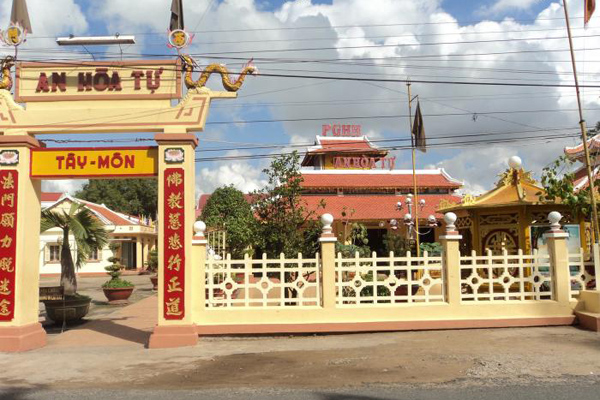
On December 18,1946, the leaders of Hoa Hao Buddhism also founded their own armed force (based on Platoon 30 formed in the August Revolution) with seven armed platoons. It was named Nguyen Trung Truc’s Revolutionary Insurgent Army Detachment for National Salvation (Nghia quan Cach mang Ve quoc Lien doi Nguyen Trung Truc), also known as Nguyen Trung Truc’s soldiers.After Huynh Phu So’s death following the event of Doc Vang on April 16,1947, Hoa Hao Buddhism’s armed force was divided into different groups, each of which oversaw a different region, as follows:
Le Quang Vinh ruled the region of Thot Not and O Mon (Can Tho);
Tran Van Soai ruled the region of Cai Von (Can Tho);
Lam Thanh Nguyen ruled the region of Chau Doc (An Giang); and
Nguyen Giac Ngo ruled the region of Cho Moi and Long Xuyen (An Giang).
During 1946-1948, Hoa Hao Buddhism’s armed force expanded rapidly. According to the French’s official statistics in 1951, it comprised 14,741 soldiers, 5,433 of which were paid while the rest were self-sufficient and depended on the tax collection. In 1953, it reached 25,000 soldiers. In 1954, there were 28,000 soldiers in the regions of Long Xuyen and Chau Doc alone. At that time, with the motto of “religious protection,” the armed force’s main activities had damaged the Revolution by attacking the resistance bases in the Mekong River Delta many times.
In 1955, the “denominational war” in the South among Caodaism, Hoa Hao Buddhism, and Binh Xuyen lasted for over three years, and made Hoa Hao Buddhism’s armed force disintegrated. As a result, its heads in turn surrendered to Ngo Dinh Diem, and became high-ranking officers in the Army of the Republic of Vietnam.
After the disintegration of its armed force, Hoa Hao Buddhism was assisted by the Sai Gon administration to establish the Hoa Hao Buddhism’s Armed Force for Self-defense (Luc luong vu trang phong ve Phat giao Hoa Hao) in Cho Moi (Long Xuyen) in May 1972. It was followed by the founding of the General Security Group (Tong doan Bao an) headed by Tran Huu Bay, alias Hai Tap. Its weaponry and military equipment were provided by the army of Sai Gon. Particularly, it was established as a system from the central to grassroots levels. By 1975, it was about 518,734 troops strong.
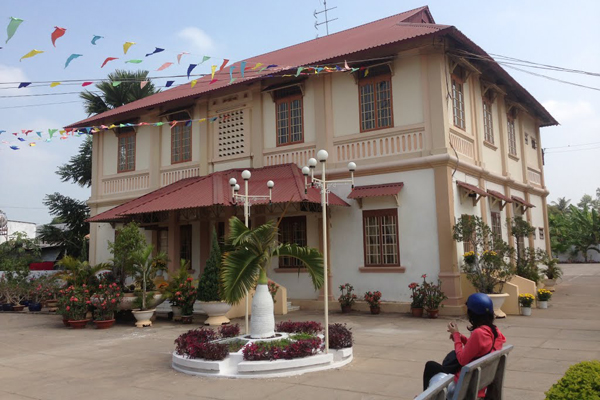
Hoa Hao Buddhism’s Management Committee was formed as early as 1945. However, the religious power system was almost ineffective because of the encroachment of Dan Xa Party and Hoa Hao Buddhism’s armed force. It was not until 1946 that its religious power was restored and strengthened following the establishment of the Hoa Hao Buddhist Sangha. Its Charter was approved by the Sai Gon administration according to Decree No. 002/65 signed by Lieutenant General Nguyen Van Thieu, Chairman of the National Leadership Committee, and issued on July 12, 1965. The First Central Management Committee (1964-1966) included seventeen members and was headed by Luong Trong Tuong. Huynh Phu So’s mother, Le Thi Nham, was appointed as its Supreme Honorary Chairman. In 1966, due to internal conflicts, the Hoa Hao Buddhist Sangha was split into three sects named after their leaders: Luong Trong Tuong sect, Nguyen Duy Hinh sect and Le Quang Liem sect. This lasted until 1975.
With the aforementioned organization and support from Dan Xa Party and the armed force, the leaders of Hoa Hao Buddhism seemed to be more attracted to politics. In fact, for a long time prior to the liberation of the South, they paid more attention to political than religious activities.
Before the liberation of the South, while Hoa Hao Buddhism’s leaders were attracted to political activities, the majority of its followers still led a religious life and participated in many patriotic activities as suggested in the teachings of Huynh Phu So.
During the August Revolution (1945), many Hoa Hao Buddhist followers joined other social classes to participate in revolts to seize power in the Southwestern provinces. Representatives of Hoa Hao Buddhism also took part in the Revolution’s machinery of government, from the South Administrative Committee to provincial and grassroots administrative committees. In the anti-French resistance (1945-1954), despite the French’s efforts to separate Hoa Hao Buddhism from the Revolution, most of its followers still supported and joined the Revolution in different forms. Even in its armed force, many military officers and soldiers escaped from French control and joined the ranks of the Revolution.
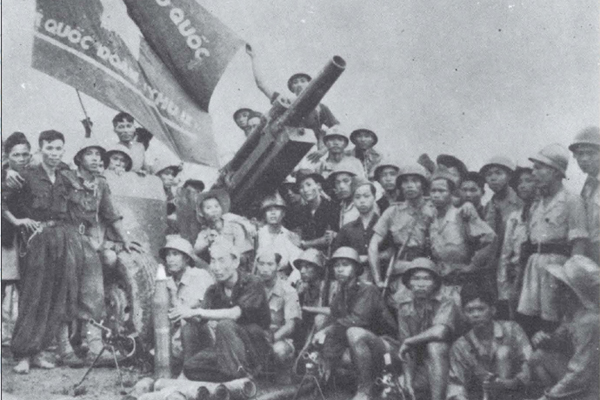
In the anti-American resistance (1954-1975), the Hoa Hao Buddhist Sangha and the security system were founded to control its followers. However most of Hoa Hao Buddists escaped from the domination and control of the Sangha and Sai Gon administration, and made contributions to the Revolution. They actively participated in the struggle against American imperialists and the Sai Gon administration for the implementation of the Geneva Agreement and the welfare and democratic rights of the people, and the fight against the arrests of soldiers and innocent people. Many of these struggles attracted thousands or even tens of thousands of believers, such as the struggle against killing unprovoked killings in Tan Chau (in July 1965), the struggle against the Phuong Hoang operation in Long Xuyen (in November 1971) and struggles against militarizing schools conducted by the students of Hoa Hao University in the early 1970s. Along with participating in resistance activities in temporarily occupied areas, many Hoa Hao Buddhists also provided material support to the Revolution and assisted in hiding revolutionaries. To sum up, in An Giang Province alone, there were 795 revolutionary martyrs’ families, 649 wounded soldiers’ families, 1,224 families deserving well of the Revolution and 6 Vietnamese heroic mothers.
The contributions of Hoa Hao Buddhism to the Revolution as above were the basis for the patriotic activities of its followers in the new period of the Revolution, especially when Vietnam entered the renovation period in 1986.

